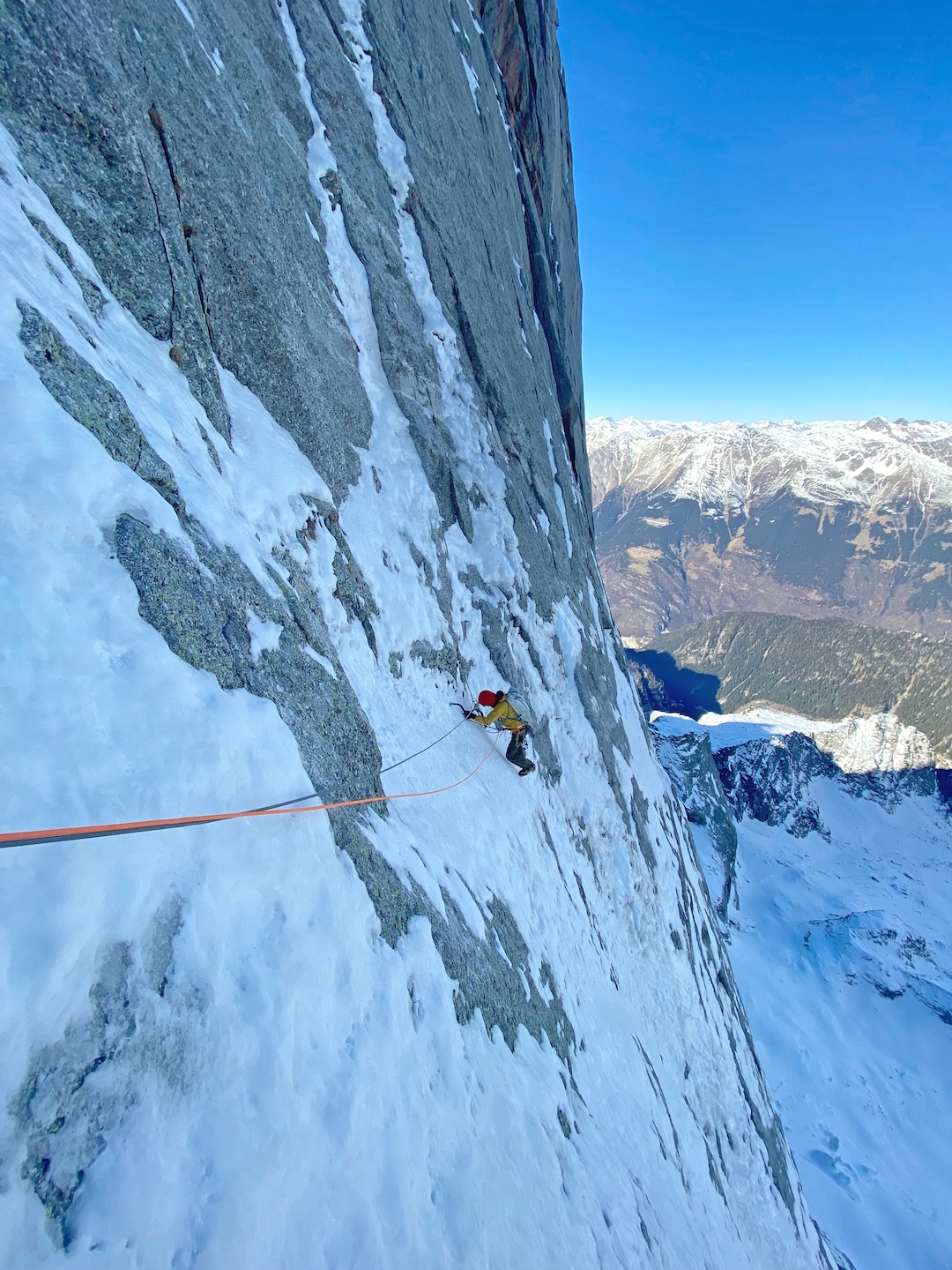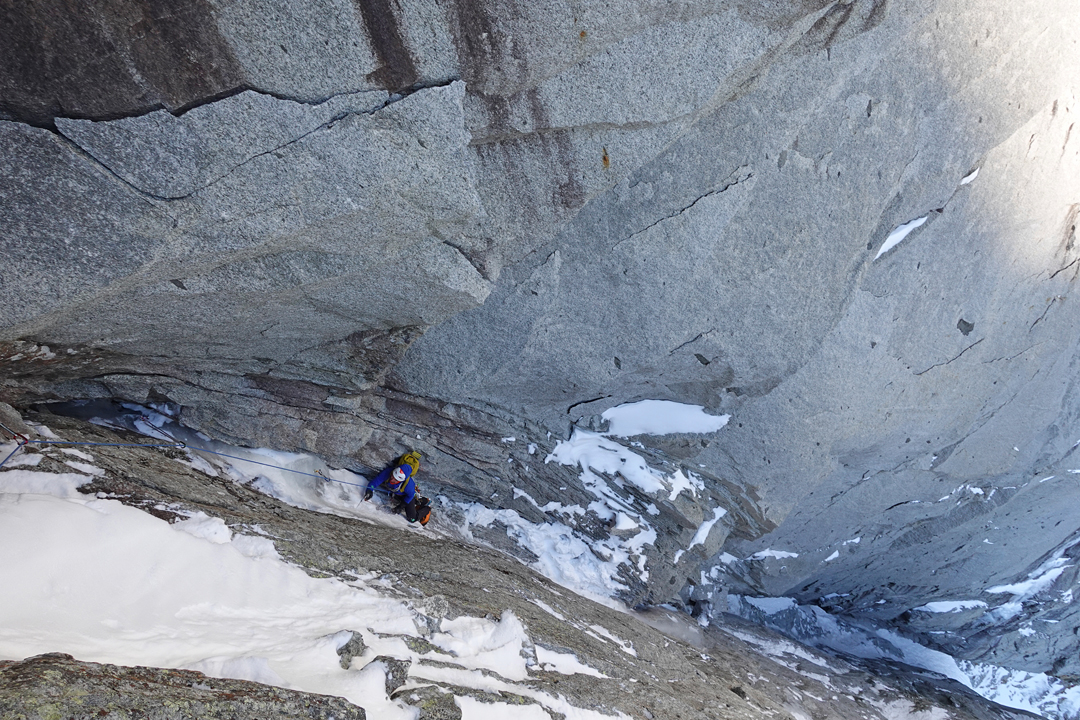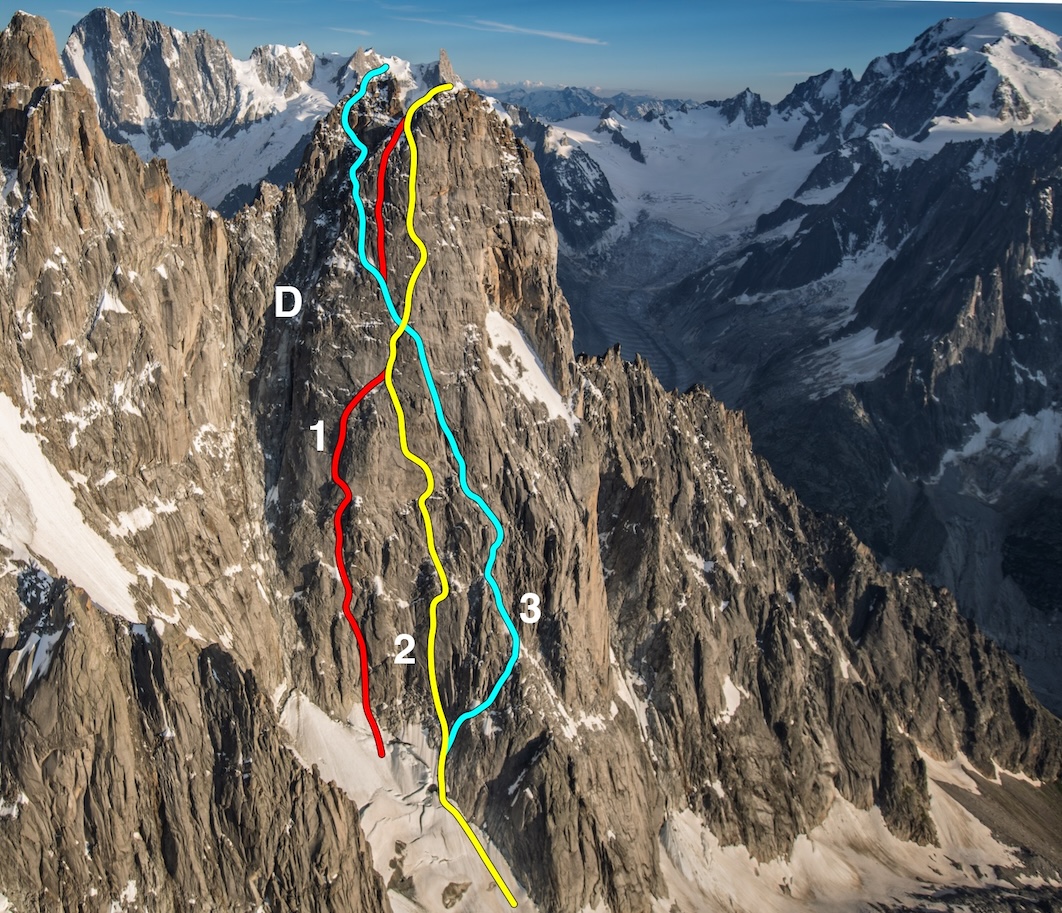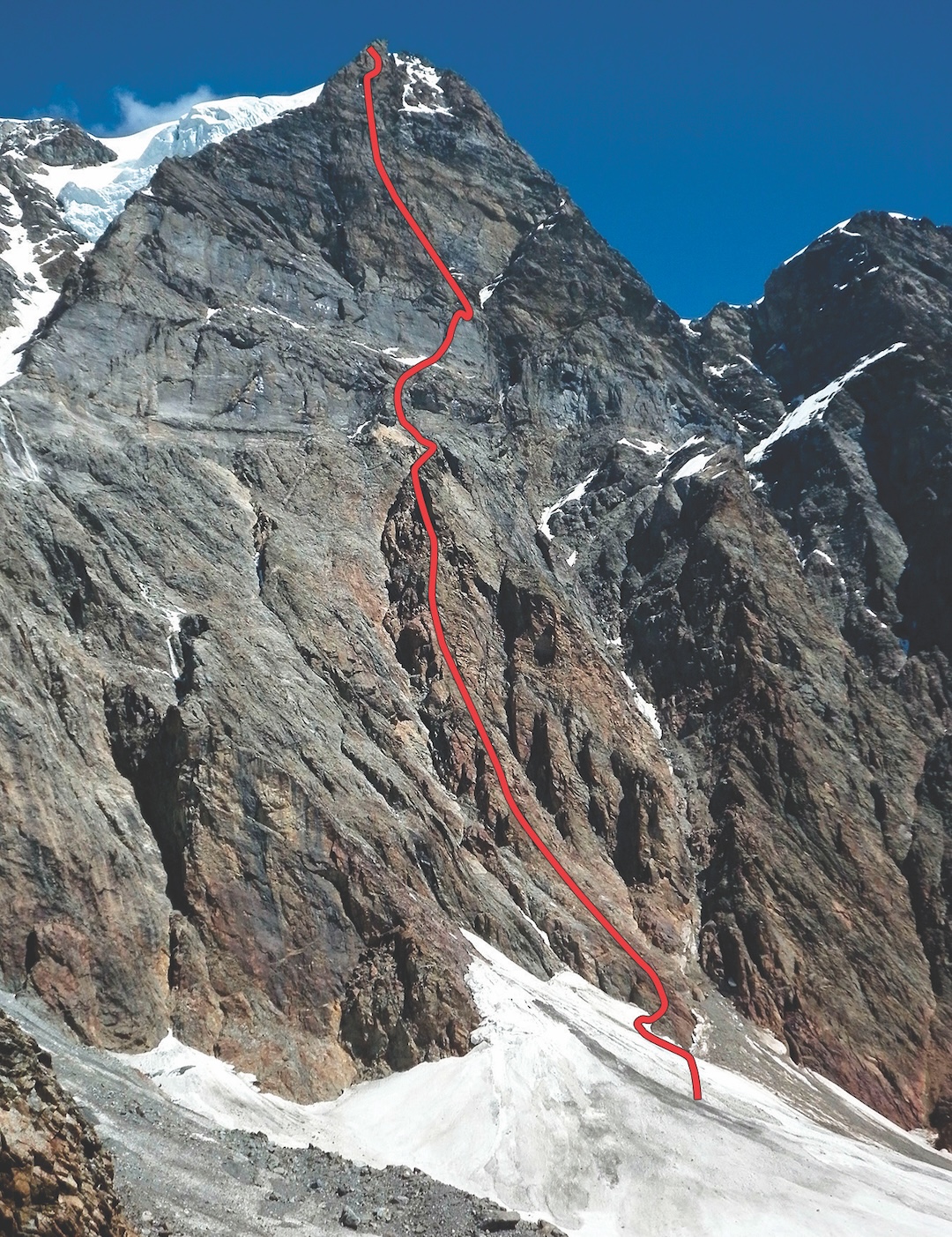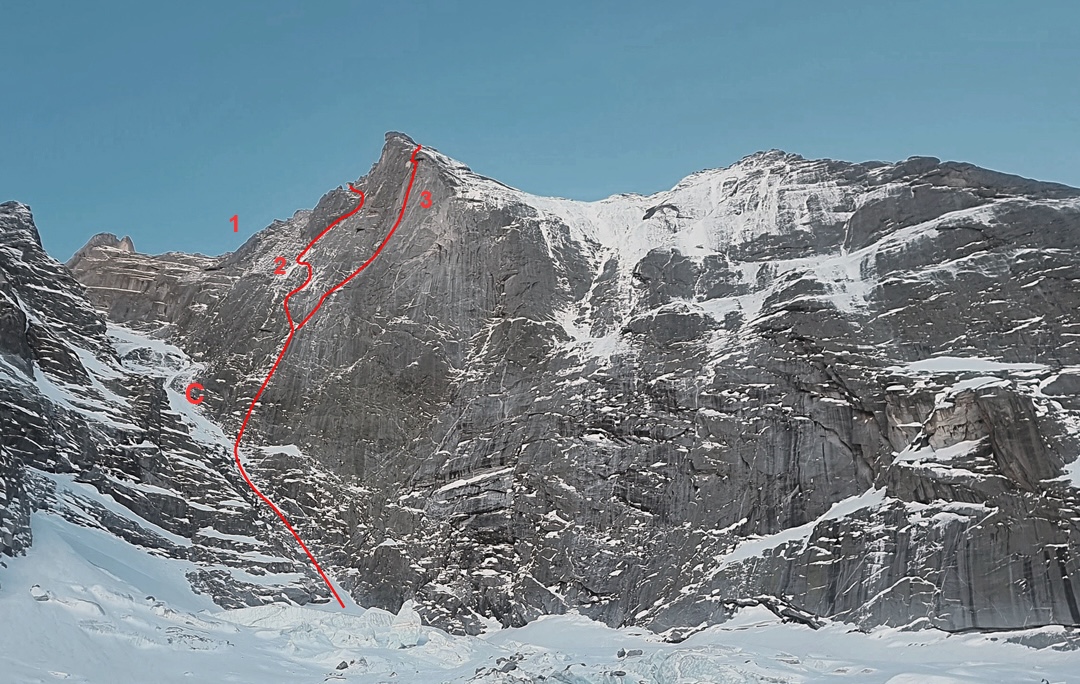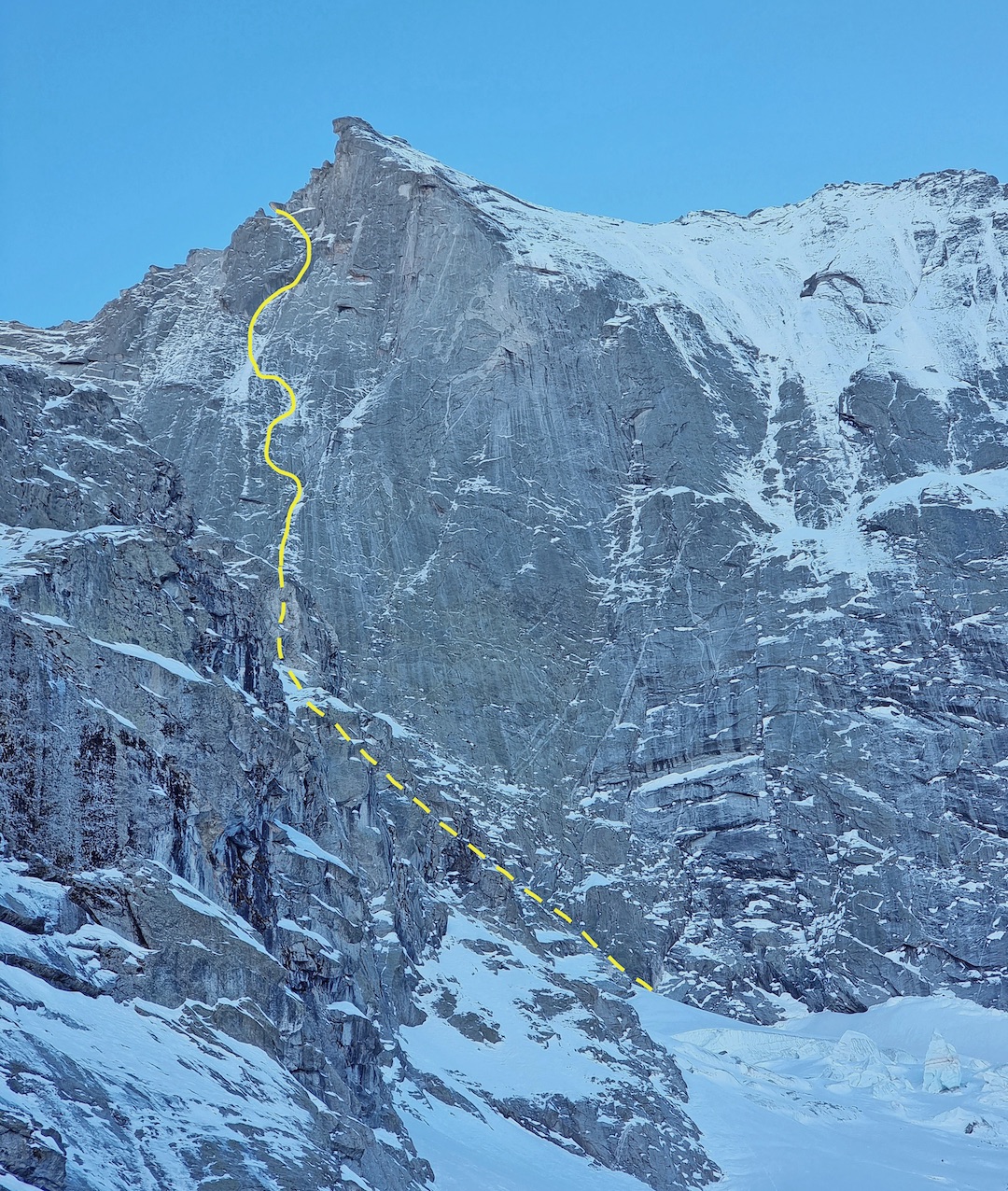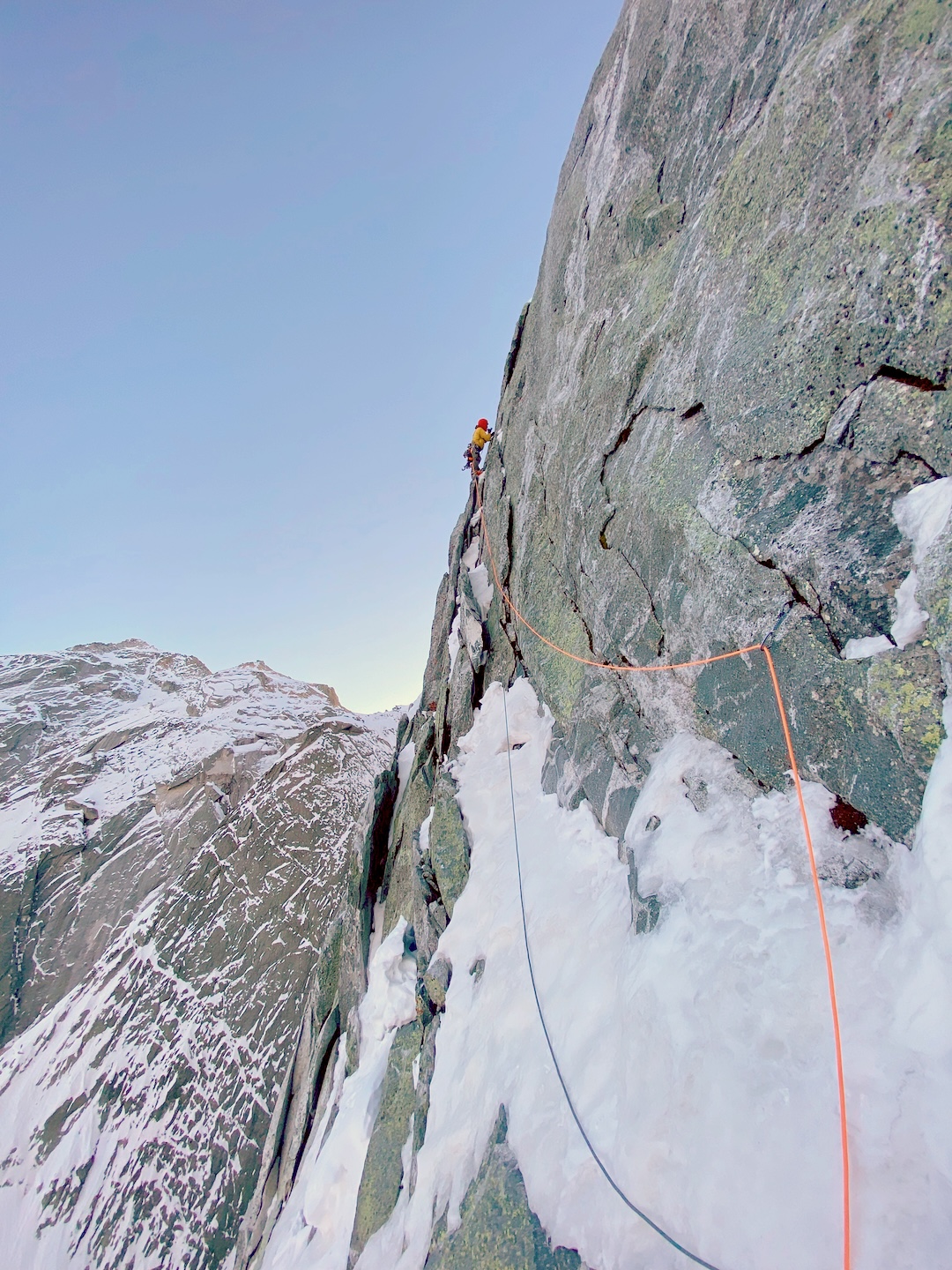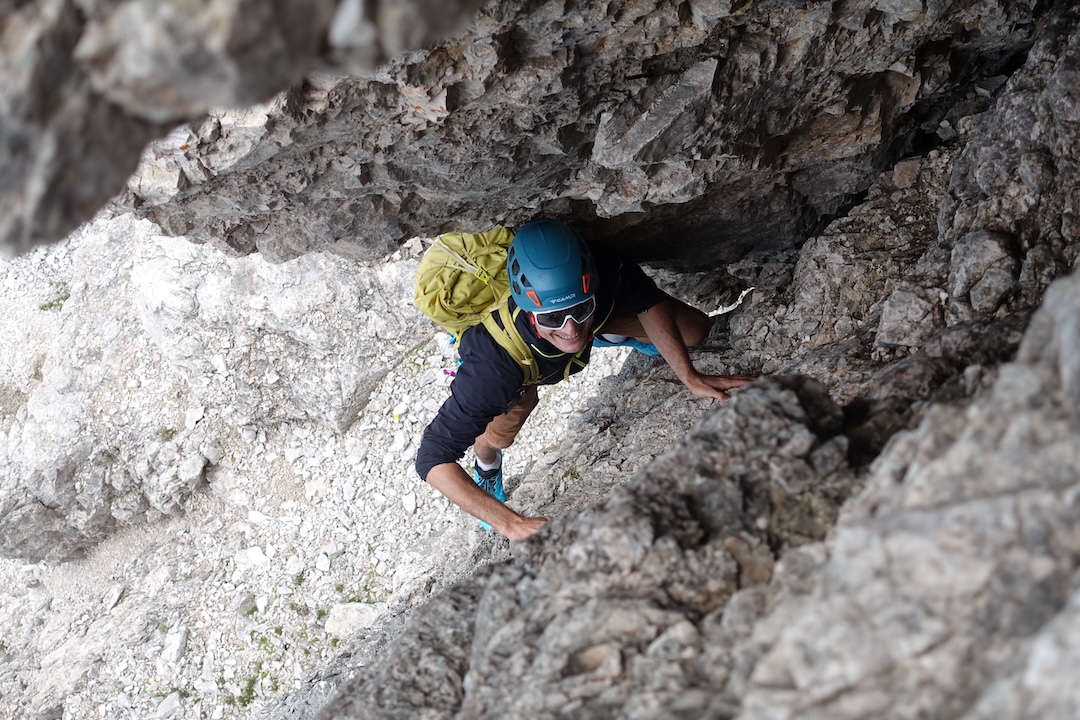Alpine Highlights, 2023–2024
Europe, The Alps
This report covers climbing exploration, innovation, and performance in the Alps during 2023 and 2024, through a small but representative selection of significant ascents.
EXPLORATION
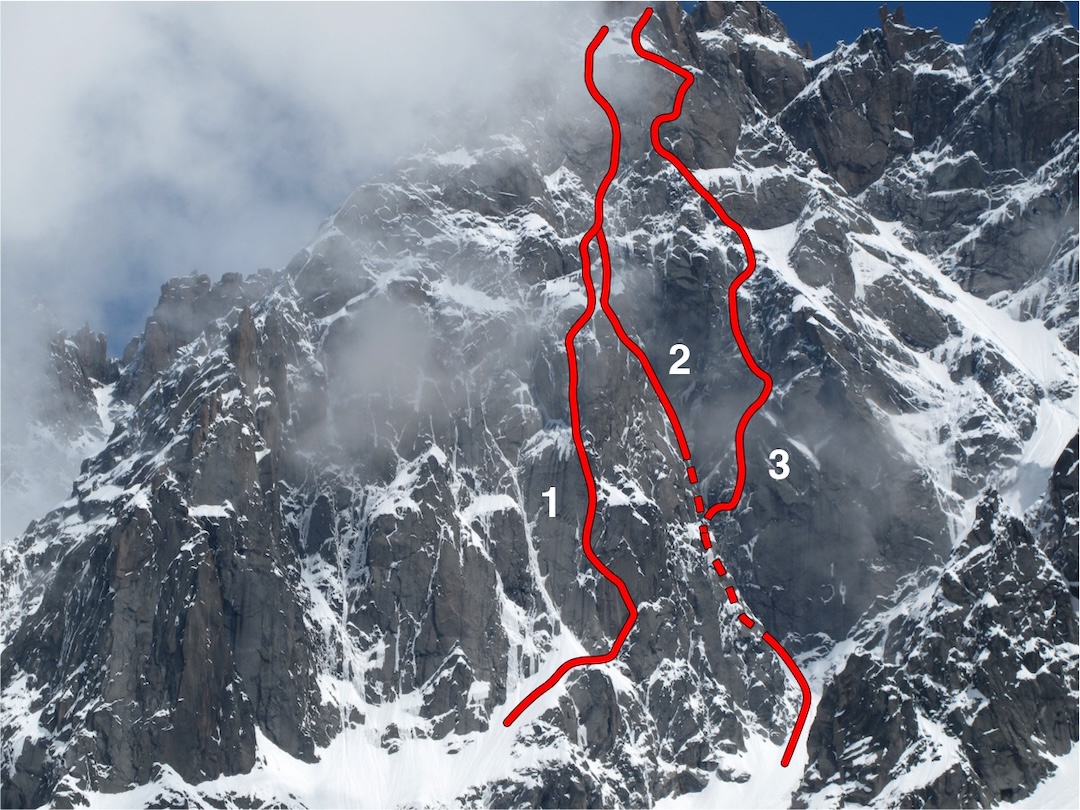
High above Chamonix, France, over three days in January 2021, Thomas Auvaro, Léo Billon, Jordi Noguere, and Sébastien Ratel climbed the hard mixed route Blast (700m, M7+ AI4+) on the northwest face of the Aiguille de Blaitière. The route begins in the prominent deep gully immediately to the right of the West Pillar (Galbraith-McKeith, 1966, VI A2). After four pitches in the couloir, Blast strikes up the flank of the large rock buttress on the right to reach its apex, then weaves through complex terrain above to finish at the north summit, Pointe de Chamonix (3,507m). Later the same year, the first four pitches were equipped with rappel anchors, forming the increasingly popular Mini Blast (AI4+ in a steep, narrow corner on pitch three).
Starting on January 27, 2023, Tom Livingstone and Rob Smith climbed Mini Blast and then continued above in a narrow, icy couloir before eventually exiting onto the Fausses Vires Fontaine, the lowest of the ledge systems that cut across the upper west face of the Blaitière. The next day they continued to the north summit, climbing similar terrain to the upper part of the old Allain-Fix route. (Pierre Allain and Auguste Fix climbed the face in 1947, left of the subsequent Brown-Whillans, but the entire lower section of the route collapsed a few years later. The upper section, above the Vires Fontaines, is rarely climbed, involving often wide and wet cracks.) Livingstone and Smith called their ca 700m route simply the Northwest Face and rated the technical difficulties M6+ AI4+.
On July 17, 2024, Léo Billon and Enzo Oddo made only the fourth ascent of a route on the north face of the Petit Dru that was put up nearly 40 years ago. In August 1986, Patrick Gabarrou and Alexis Long climbed the steep walls left of the Lesueur Route, eventually cutting through this and the Voie des Guides to finish directly on the summit. The route was largely free and was named Direttissima Jean-Claude Bertrand after Gabarrou’s best friend, who was killed by rockfall in 1975. Billon and Oddo climbed the route free in just seven hours, with three pitches of 6c and 7a, the rest easier. The rock was surprisingly good and looked equally so out to the left, where, between the Direttissima and the 1979 Czechoslovak Route, lies the steepest and most compact area of this austere wall.
They returned on July 24. After scoping a possible line with binoculars, they set off at 1 p.m. and quickly dispatched the initial pitches, finding the rock sound and very abrasive. Billon then started up pitch five, and after placing a bolt and leaving the drill, ran it out. The terrain proved much harder than expected, and at one point he was unable to move up or down, but completed the pitch with mandatory 7c climbing. The two bivouacked and the next day quickly arrived at the technical crux (8a). After Oddo had fallen twice, Billon got it second try. After another bivouac, the two reached the top in late morning of the 26th, having created Les Bâtards (800m, around 24 pitches, 8a with obligatory 7c climbing).
Toward the top, this route cuts through the Lesueur, a legendary line put up in 1952—and hugely advanced for its time—by Henri and Pierre Lesueur. The two Parisian brothers had just done the Walker Spur on the Grandes Jorasses and descended back on the French side. Having arrived at Montenvers, with the weather still good, they were lured by the Dru and decided to have a look at its north side. Climbing these two major routes in succession was a remarkable “enchainment” for the day. Their line on the Dru remained unrepeated until the summer of 1975, when it was climbed by Rab Carrington and Alan Rouse, and although various parties in more recent times have claimed the first free ascent, it is largely unknown that this feat was achieved way back in 1983, on the first winter ascent, by Andy Parkin and Thierry Renault.
Also on the Petit Dru, Baptiste Obino joined Philippe Bruley and Amaury Fouillade on a seven-day ascent of a new route, Petit Pont (1,000m, 6a A3 M5), on the west face. They reached the summit on New Year’s Day of 2025. The new line lies on the left side of the giant rock scar, roughly parallel and a little to the right of the 2021 French route BASE, joining it toward the top. Though often in the firing line from a party repeating the somewhat looser BASE at the same time, the three alpinists found reasonably solid if extremely steep, compact rock and felt it could all go free.
Patrick Gabarrou, mentioned above, might be the most prolific exploratory climber in the history of the Western Alps. In August 2024, he returned to the west side of Mont Blanc and over two days climbed a new line, Marie, Porte du Ciel (700m, TD 6a) on the Pointe Louis-Amédée (4,460m), with Clément Dumont and Clément Parisse. This plugged the gap between Gabarrou’s own 1989 line, Himalamiage, and the 2018 route Perfect Storm. Gabarrou was 73 at the time and has suggested this will be his last new route on the great mountain.
The most notable new line completed in the Écrins Massif of France during 2023 was arguably that by Julien Cruvellier de Luze, Nicolas Jean, and Benjamin Védrines, who ascended the last major unclimbed couloir on the south face of the Barre des Écrins (4,101m). De l’Or en Barre ascends La Gorge, the stone-swept, 1,000m-high canyon that lies between the classic South Pillar (TD V+, 1944) and Arête Rouge (D+ IV+, 1926, one of the first major new routes climbed guideless by a French party). A direct ascent of La Gorge had never been tried.
Rather than follow the standard summer approach up the Glacier Noir from Pré de Madame Carle, the team elected to skin up to the Col des Avalanches from the southwest, where they left skis and descended the couloir on the far side to the base of the route. That day, January 28, they climbed to a comfortable snow cave bivouac, and the following day finished on the summit at
7 p.m. The three climbed the route in around 24 pitches, some of them wild, with difficulties rated as 6a+ A1 M7 WI5+. For the last 200m, they followed the direct finish to the Arête Rouge, climbed in July 1976 by Jean-Michel Cambon, Bernard Francou, and Catherine Martin-Cambon (TD- V+). It only remained for them to downclimb to the Col des Avalanches, regain their skis, and descend by moonlight to the valley.
One year later, Baptiste Obino made the first ascent of possibly the last logical unclimbed line on the south face of La Meije (3,983m), rope-soloing, with three bivouacs, the couloir dropping from the Brèche Zsigmondy (3,925m). It was too dry in the upper part, which had loose granite and significant rockfall, so he finished up the right-hand face, though in hindsight a direct and more aesthetic finish out left to the summit looked possible. Pantouflage et Sabotage was 750m (11 pitches) with difficulties of 6c A2 WI5+ M7. Obino spent a rough night—February 18—at the top of the couloir, buffeted by high wind that prevented a traverse to the normal route the next day. Instead, he rappelled his ascent route.
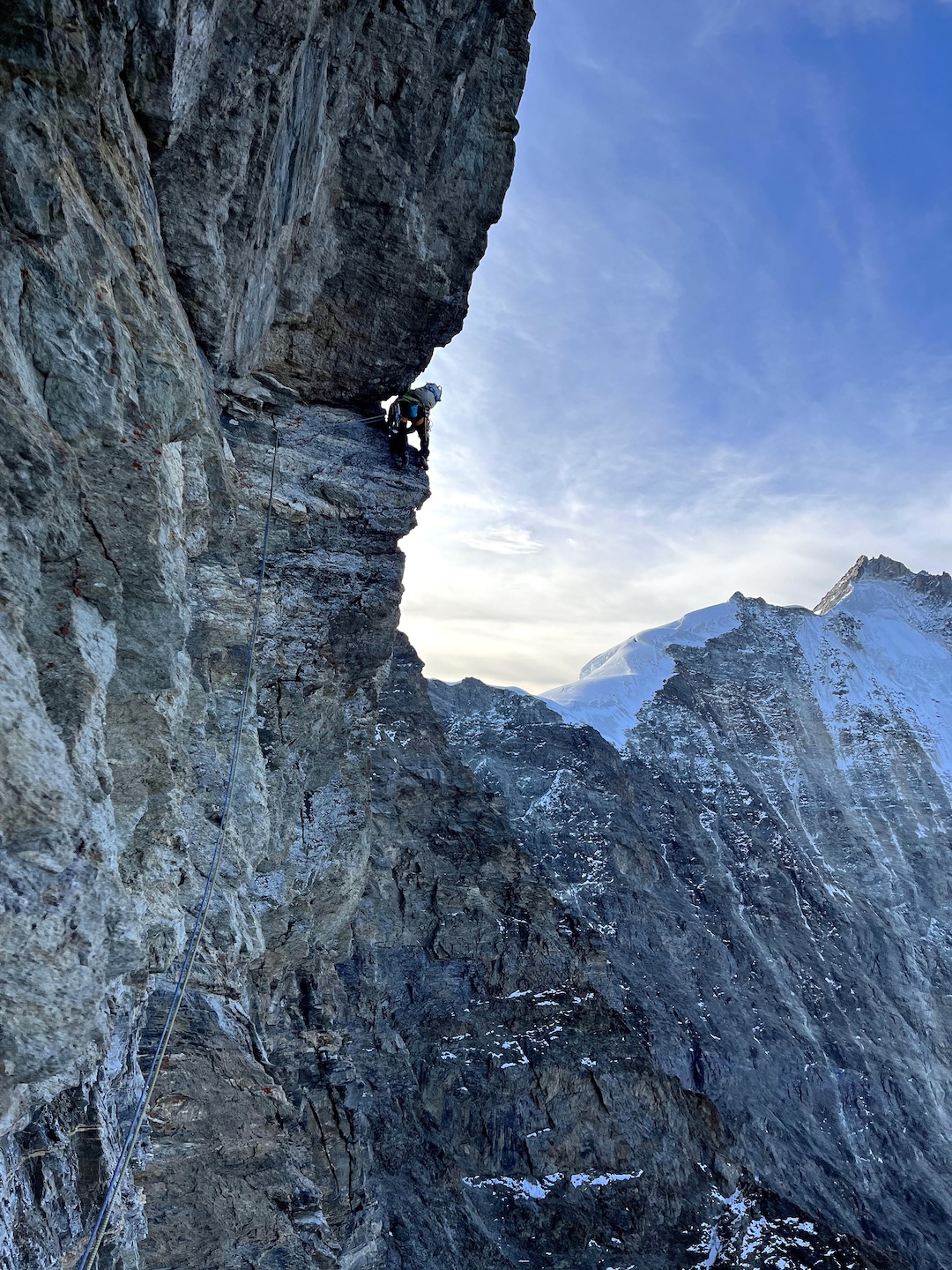
A big unclimbed face in the Alps, let alone in Switzerland’s Bernese Oberland, is something of a rarity, but the southwest face of the Rottalhorn (3,971m), immediately south of the Jungfrau, had been noted by Matteo Della Bordella and Silvan Schüpbach, who made the first attempt on this untouched 1,050m rock wall during the summer of 2011. The face was not visited again until October 12, 2023, when Schüpbach returned with Peter von Känel and Rolf Zurbrügg.
The three climbed the lower face (III and IV with two pitches of 6a) and at dawn reached a steep barrier where the rock changes from gneiss to limestone. Here they found two demanding pitches of 6b, leading to an upper pillar of gneiss where they opted to climb the better rock rather than the easiest line. Reaching the summit in early afternoon, rather quicker than expected, they traversed the glacier to the tourist-thronged Jungfraujoch station, a complete contrast to the solitude of the morning, and took the train down to the valley. The route was named Herbstwanderung and was climbed on natural gear throughout.
[Editor's Note: Subsequent to the printing of this edition of the AAJ, it became known that an attempt was made to climb the southwest face of the Rottalhorn in February 1983. Dick Renshaw and Stephen Venables, both from the U.K., climbed the prominent snow couloir on the right side of the face for around 350m until it petered out at a steep ramp leading to an overhanging chimney. Above this and a black rock band, they hoped to finish up a right-slanting ramp across the headwall. The first pitch up the initial steep ramp gave absorbing climbing with little protection, and the start of the following pitch proved hard and insecure. With the way ahead seemingly even harder and devoid of belays, they retreated.]
One of the most notable summer ascents in the Eastern Alps during 2023 was the new route Madre Roccia on the south face of the Queen of the Dolomites, the Marmolada.
In 1988, the accomplished Maurizio Giordani and his wife, Rosanna Manfrini (the first woman to summit Cerro Torre), climbed a steep and compact, barrel-like buttress on the lower half of the south face of Marmolada di Ombretta (3,343m), then continued more easily above the halfway ledge to the summit. Their route, Specchio di Sara (800m, 7b+/7a obl.) was a masterpiece of bold slab climbing and featured very spaced, hand-drilled bolts. A little later Stefano Righetti tried a futuristic line on the far right of the buttress but ground to a halt when faced with “blank” rock. Since then, around eight routes have been added to this excellent buttress, including Steps across the Border by Luggi “Darshano” Rieser and Ingo Knapp, who eventually freed their route in 1995—possibly the first big route in the Dolomites of grade 8a to be climbed without bolts.
Madre Roccia completes Righetti’s project, and the team that did it—Iris Bielli, Matteo Della Bordella, Massimo Faletti, and Giordani—spanned four “generations” of Italian climbing, from the rising star Bielli to the elder Giordani. Beginning work on the line in 2023, they eventually split into two teams to complete the free ascent. On September 28–29, 2024, Bielli and Della Bordella climbed the ten-pitch lower wall at 8b (7c obl.), while the other two completed the ten-pitch line on the upper wall, left of Specchio di Sara, at 6b maximum. With only 18 bolts placed, there are often long runouts over difficult terrain, and a continuous ascent remains.
Immediately to the right of the Specchio di Sara wall stands the Elephant Pillar, a steep, rounded buttress falling from the midway terrace. Giordani climbed its compact slabs and walls in 1983, creating Ali Baba. In 2024, Faletti and Berni Rivadossi started up Ali Baba and then continued direct to the top in a total of ten pitches, forcing the compact wall between Ali Baba and Enola Gay to give Ego Land. On August 28, Rivadossi and Luca Bana made the first (team) free ascent at a grade of 8c/8c+ (7c+ obl.), making this one of the most difficult multipitch routes in the Dolomites.
INNOVATION
In January 2023, Marcel Schenk (with Simone Porta) made a rare winter ascent of the Isherwood-Kosterlitz Route (600m, originally VI A1/A2, climbed free at VIII and in winter at M8) on the east-northeast face of the Piz Badile in Switzerland. Realizing that conditions were excellent, with not too much winter snow on the ground, Schenk enticed David Hefti with a proposal to try the first winter ascent of the seldom-climbed Battaglia-Corti Route just to the left.
In 1953, Felice Battaglia and Claudio Corti were attracted by the most prominent feature on the east-northeast face, a huge crack system starting partway up the northwest couloir of the Colle del Cengalo and leading to a clean-cut corner. Three pitches up, they were forced out left to a parallel crack, and over two days they worked up the face above, largely on aid (130 placements), to reach the east ridge. They were now fighting a typically violent “Badile storm,” and on the crest Battaglia was killed by lightning. Corti reached the summit and descended alone. The crack and corner that lured Conti onto the face were eventually climbed over two days in 1968 by Dick Isherwood and Mike Kosterlitz, thinking they were repeating the Corti route. In fact, the correct line of the 1953 route remained a source of debate for many years, prompting Corti himself to make the second ascent in 1975. The route has subsequently been climbed free at around 6a, with two points of aid in a wet chimney.
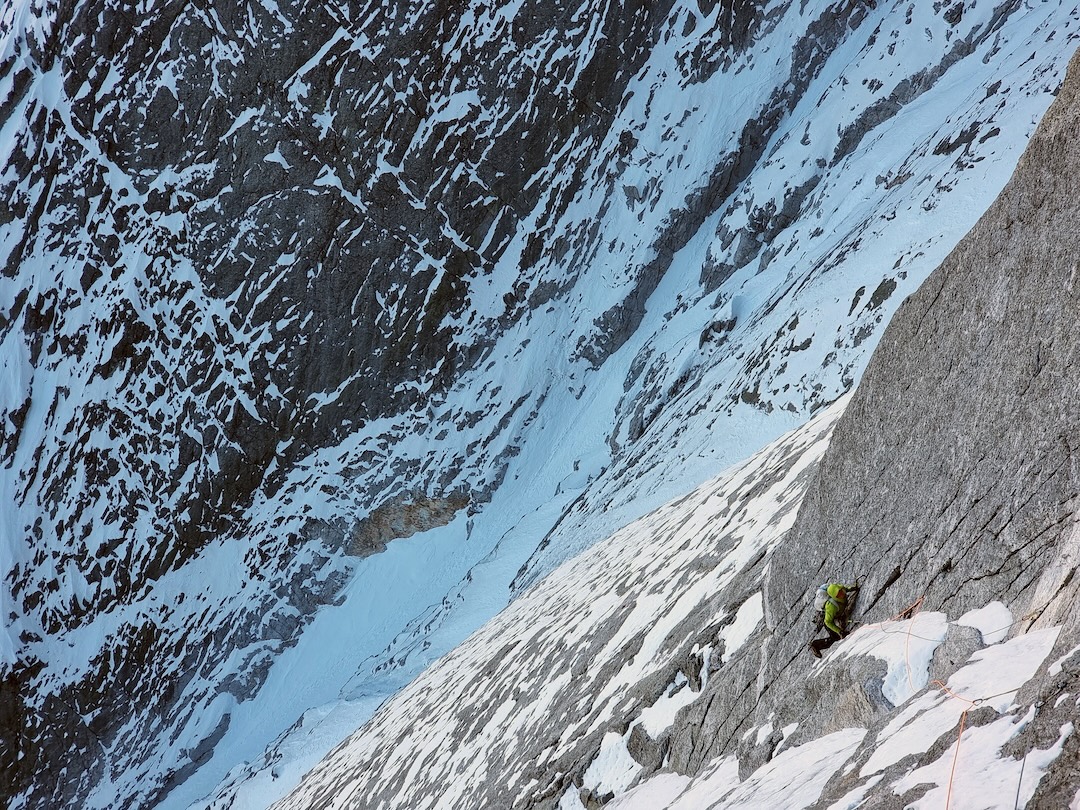
Hefti and Schenk left the Sciora Hut on February 14 and made quick progress up the first three pitches, which are shared by the Battaglia-Corti and Isherwood-Kosterlitz routes. However, the leftward traverse onto the 1953 route was difficult, with good axe placements but little for the feet, and, characteristically for the Badile in winter, run-out climbing. Two pitches higher up on the face were considered among the best the pair had ever climbed.
Thirteen hours after leaving the hut, they exited onto the east ridge about 50 vertical meters below the summit. With only two hours of daylight remaining, they decided to go down from this point, descending the ridge to the Colle del Cengalo, then down the northwest couloir to regain their skis. During their ascent, they found only six pitons, most of these originating from the first ascent. They climbed the entire route in ten pitches, sometimes up to 70m, with difficulties of M7 AI4+ R, all on natural gear.
The north side of the Cime di Lavaredo is perhaps the most recognizable view in the Dolomites. A west-to-east traverse from Cima Ovest to the Cima Piccolissima, crossing the famed Tre Cime, has been completed a number of times in both summer and winter. However, before 2024 no one appears to have traversed the entire skyline of the nine Lavaredo summits, adding four summits on the west end. In preparation for their traverse, Germans Christian Bickel and Micha Rinn equipped a rappel descent from the summit of Torre Comici into the gap before Cima Ovest, re-equipped the rappel anchors from Punta Frida toward the Piccolissima, and cached water before the Ovest.
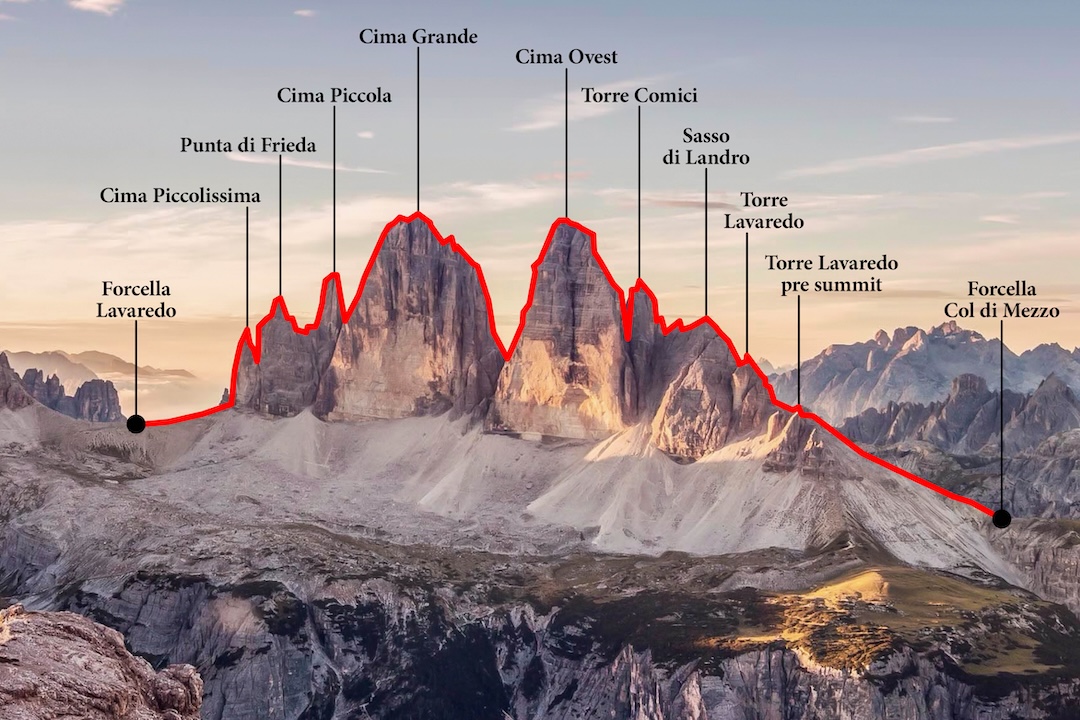
Starting from the Forcella Col di Mezzo (2,315m) in the west at 4 a.m. on July 23, they completed the skyline traverse to the Forcella Lavaredo (2,454m) with one bivouac near the summit of Cima Ovest. The nine summits crossed were: Torre Lavaredo foresummit (2,500m), Torre Lavaredo (2,536m), Sasso di Landro (2,763m), Torre Comici (2,780m), Cima Ovest (2,973m), Cima Grande (2,999m), Cima Piccola (2,857m), Punta di Frida (2,792m), and Cima Piccolissima (2,700m). The climbers used approach shoes throughout and climbed much of the route unroped, which required intense concentration on exposed, brittle limestone. The total ascent was 2,030m; the most difficult climbing was 6a on the Torre Lavaredo; and the technical highlight was a pendulum across the couloir between Frida and the Piccolissima.
PERFORMANCE
On February 15, 2023, Léo Billon and Benjamin Védrines left Chamonix at 1:30 a.m., walked up to Montenvers, and continued up the Mer de Glace to the foot of the Grandes Jorasses, which they reached at around 7 a.m. In just 9 hours, 15 minutes, they scorched up the Serge Gousseault Route, named for the climber who died on the first attempt, on the left flank of the Walker Spur (Bertone-Claret-Desmaison, 1973, 1,200m, 30+ pitches, ED3 and free at around 6b M6). From the summit, they took a further four hours to descend to the Val Ferret, completing a valley-to-valley odyssey in 19 hours.
The two upped the ante almost one year later with a project barely imaginable until relatively recently. Over three days, January 28–30, 2024, they linked the Voie des Guides (850m, M8+) on the north face of the Drus, the 1,000m Šimon-Slavík (M7+, often referred to as the Rhem-Vimal after the winter ascensionists) on the north face of Les Droites, and No Siesta (1,100m, M8 WI6) on the north face of the Grandes Jorasses. Each route—ED3 or above—was completed in 12 hours or less.
A similar achievement, this time in July 2024, was a round-trip ascent from Courmayeur of the historic rock route Divine Providence on the Grand Pilier d’Angle in just 23 hours and 45 minutes. Having trained all spring with this project in mind, François Cazzanelli and Giuseppe Vidoni approached at night via the path toward the Brenva Bivouac, crossed the Brenva Glacier, and then climbed the 18-pitch route in ten hours. They continued for four hours to the summit of Mont Blanc via the Peuterey Ridge, then down the normal Italian Route via the Gonella Hut, for a total of 28km and 3,900m of vertical gain.
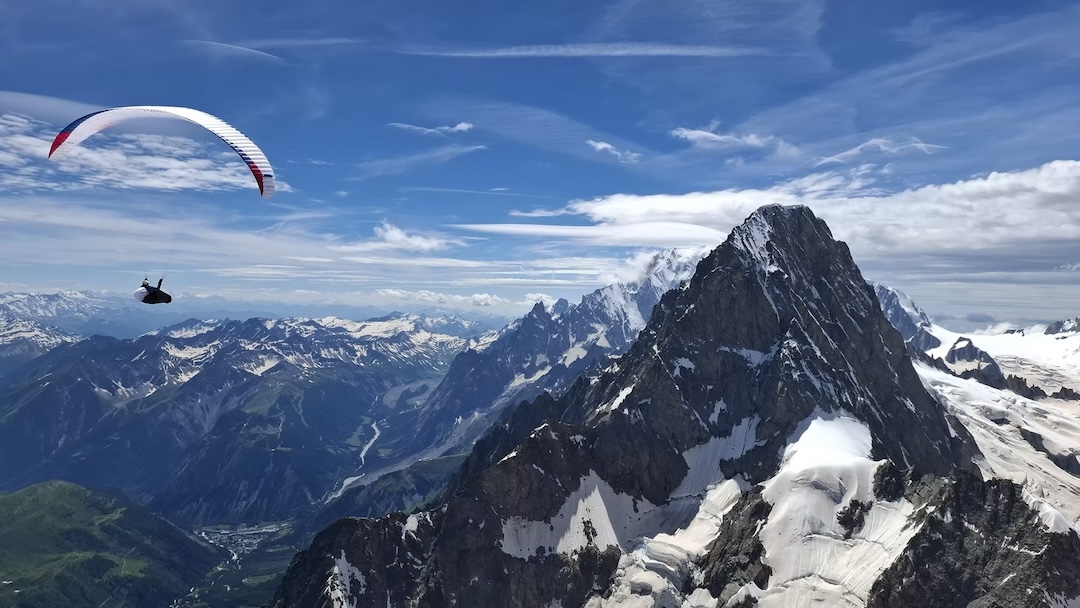
In June and July 2024, Swiss mountain guide Peter von Känel and professional paraglider Christian “Chrigel” Maurer climbed all 82 of the Alps’ 4,000m peaks in just 51 days, linking the summits by non-mechanized means. This took nine days off the record established in 2008 by Franco Nicolini and Diego Giovannini, who used only foot, bike, and skis. The two Swiss used skis as well, but also made extensive use of paragliders to transfer between peaks.
But there was an even more impressive performance to come. In just 19 days, finishing on August 31, Kilian Jornet completed all 82 peaks by foot and bike, including more than 160 different routes (up to 5c) climbed up or down. On many days he pushed his body to the limit, for instance when he left the Monte Rosa hut after three hours’ rest and traversed 18 4,000m peaks that same day. He was accompanied to 34 of the summits by friends, and at times by a small film crew, who also helped with the complex logistics. As a purely sporting achievement, combining endurance with speed over medium-grade terrain, there has been nothing quite like this in the Alps.
—Lindsay Griffin, AAJ, with assistance from Rodolphe Popier and the climbers


